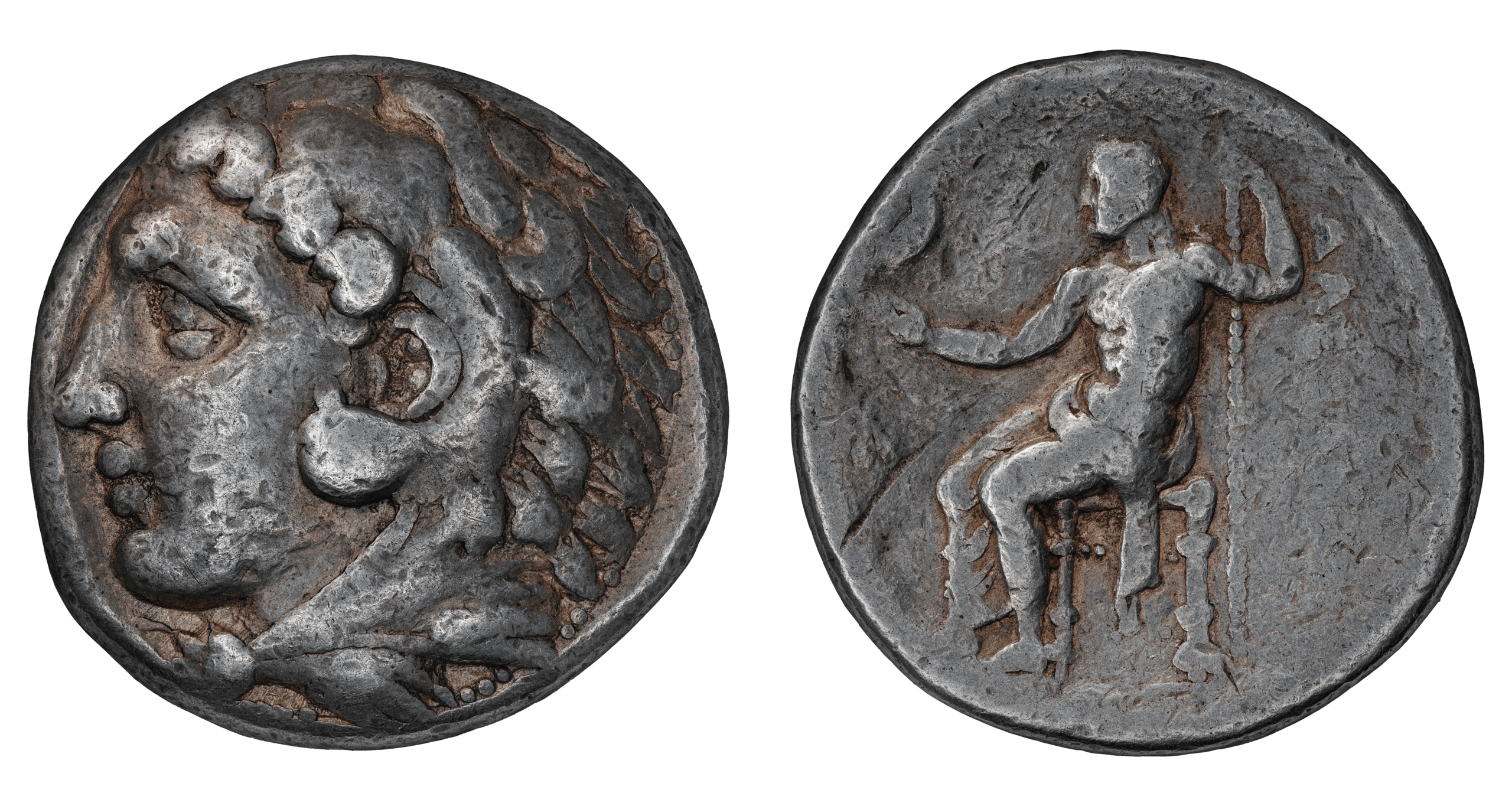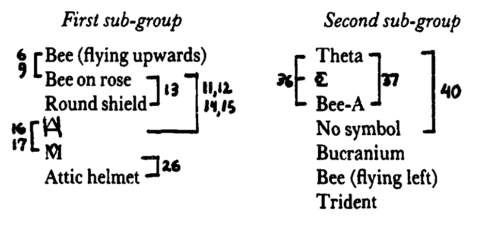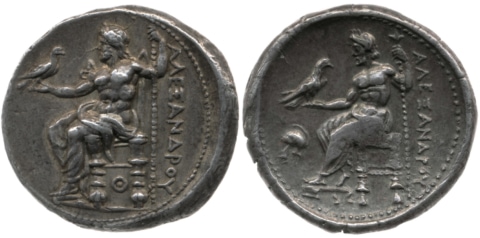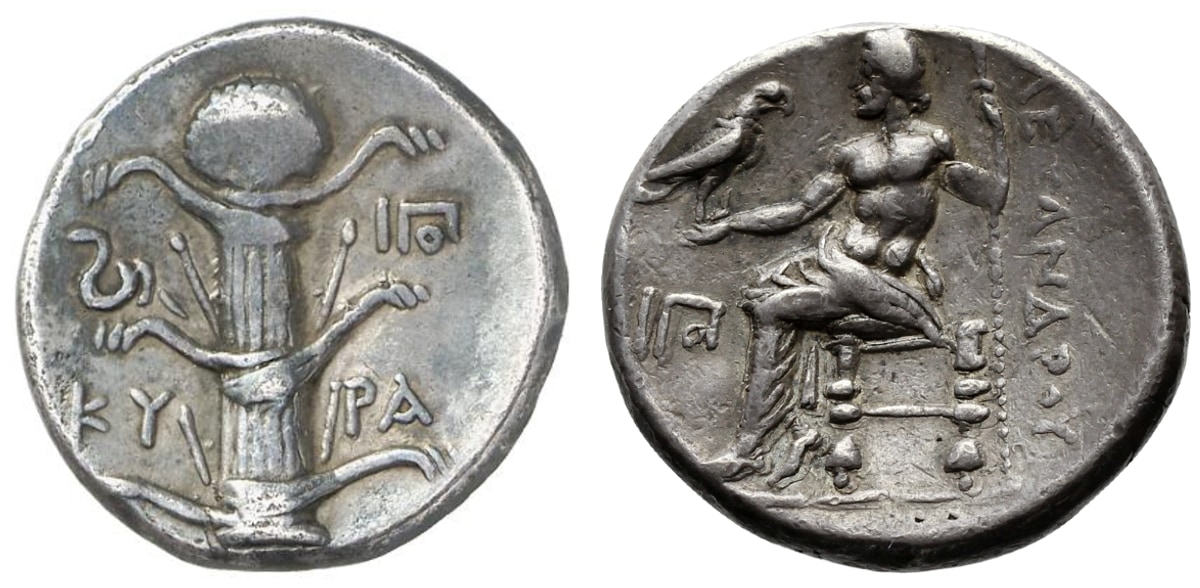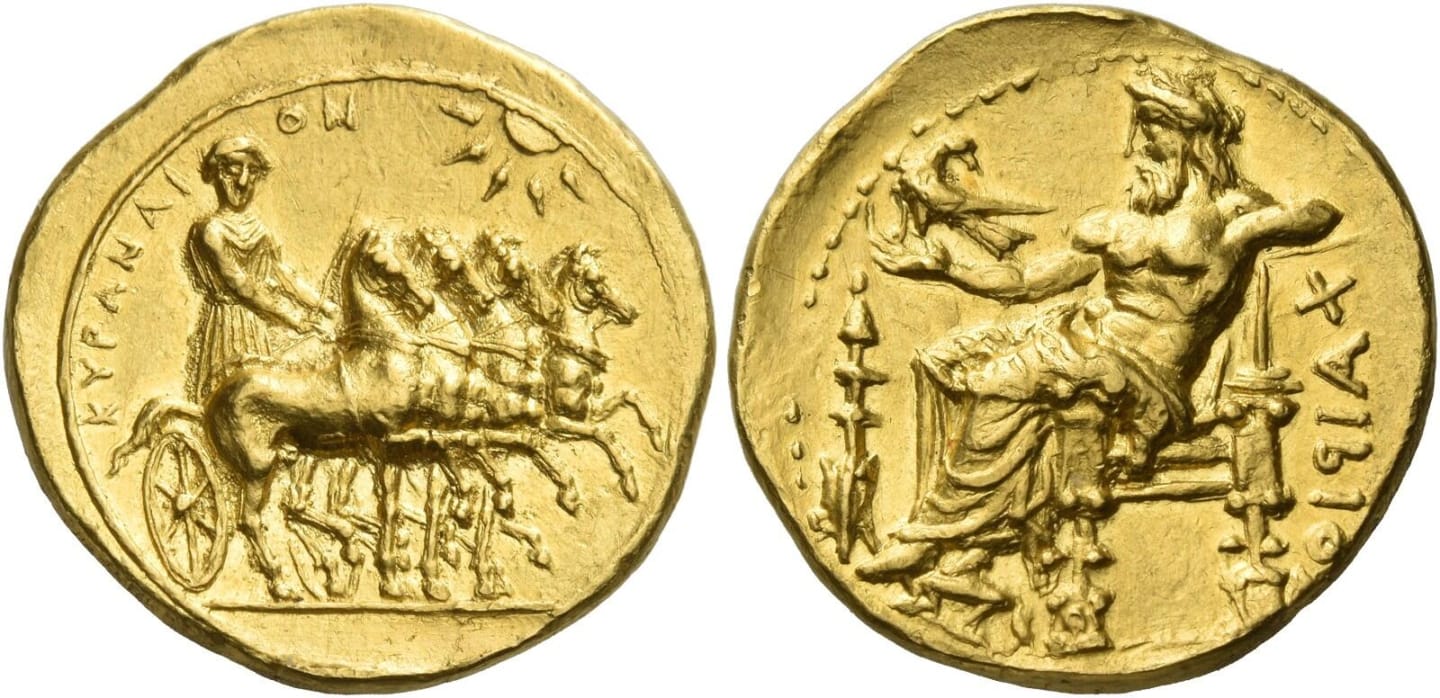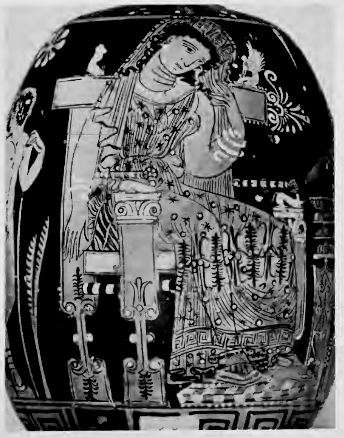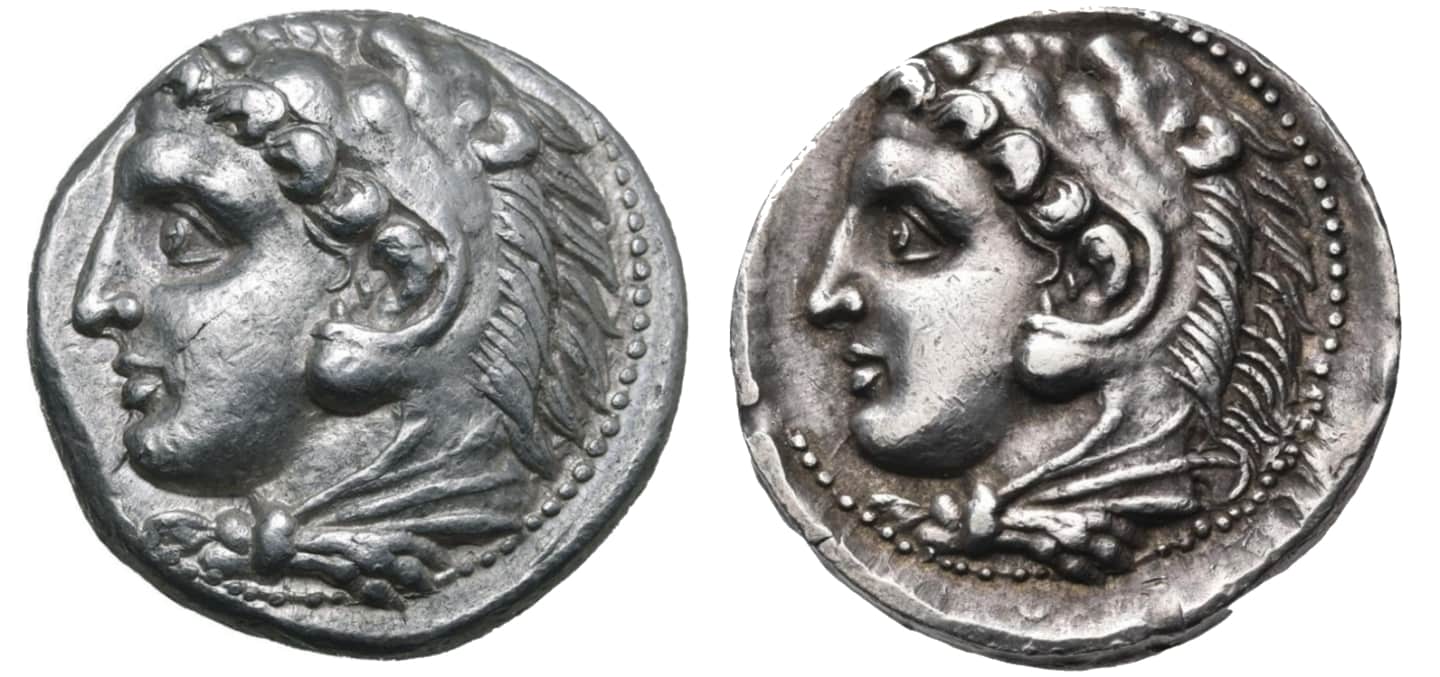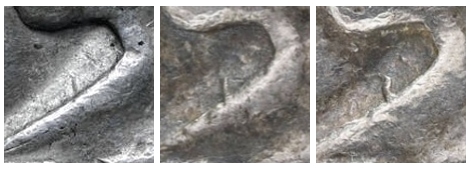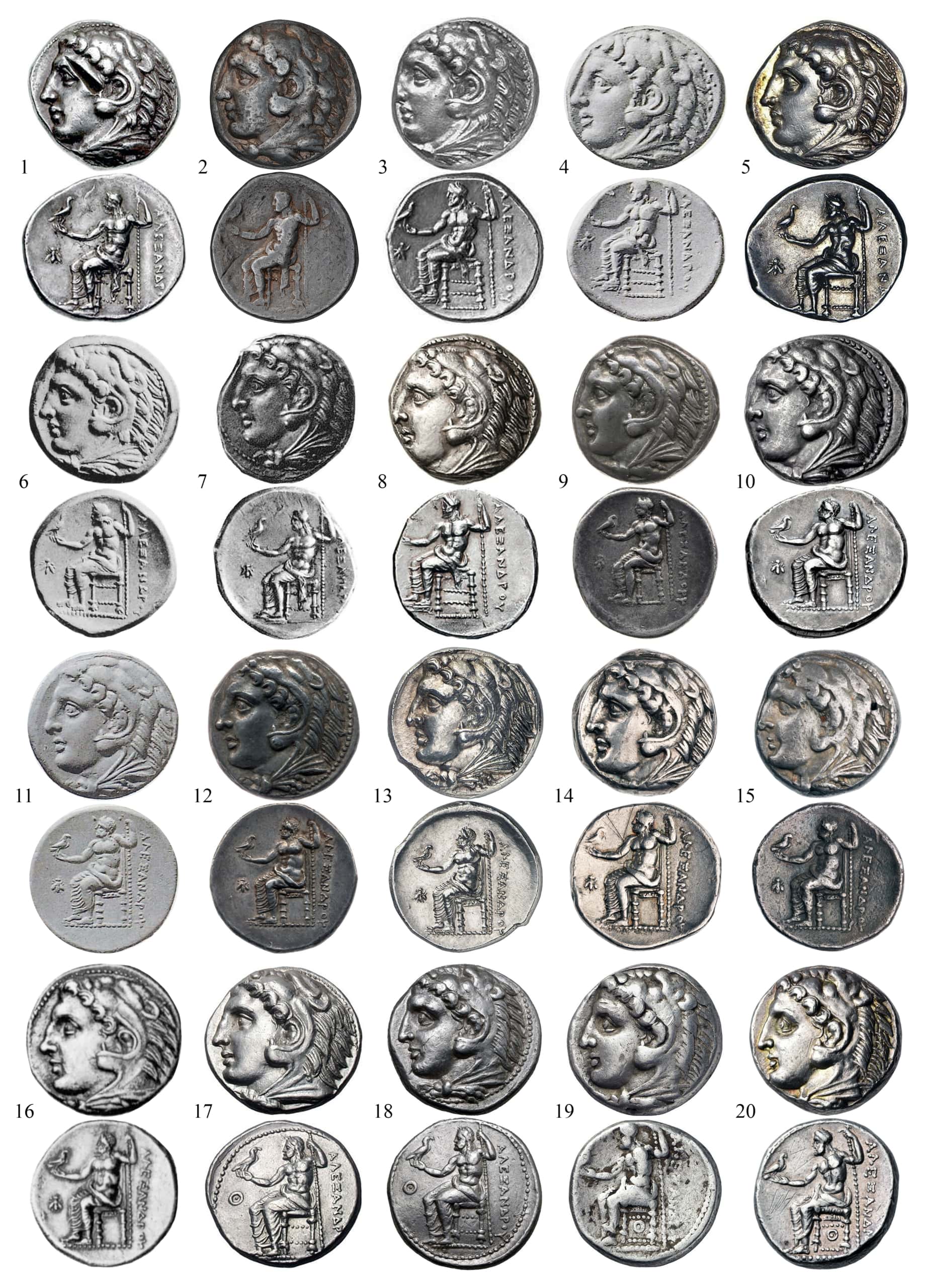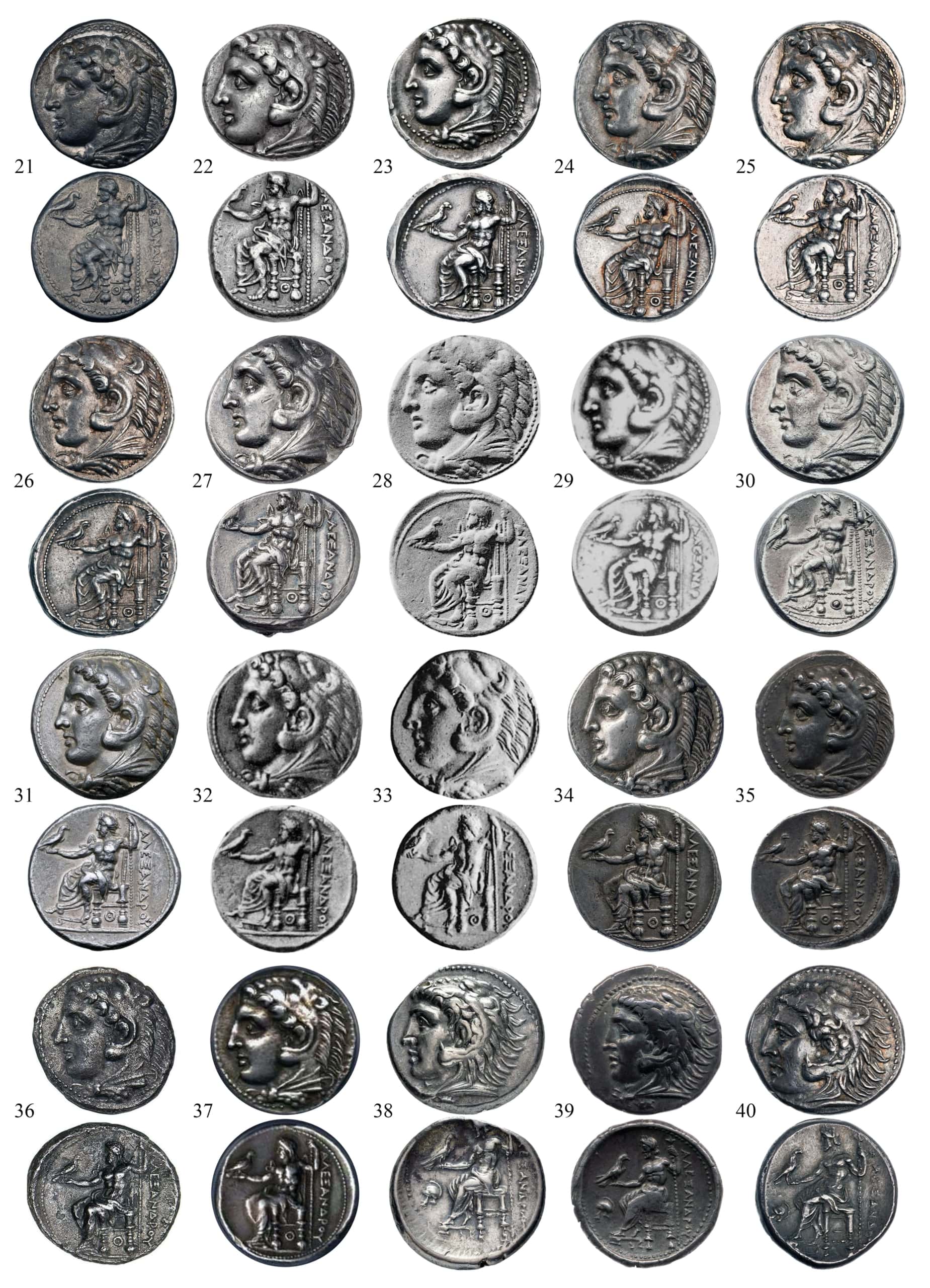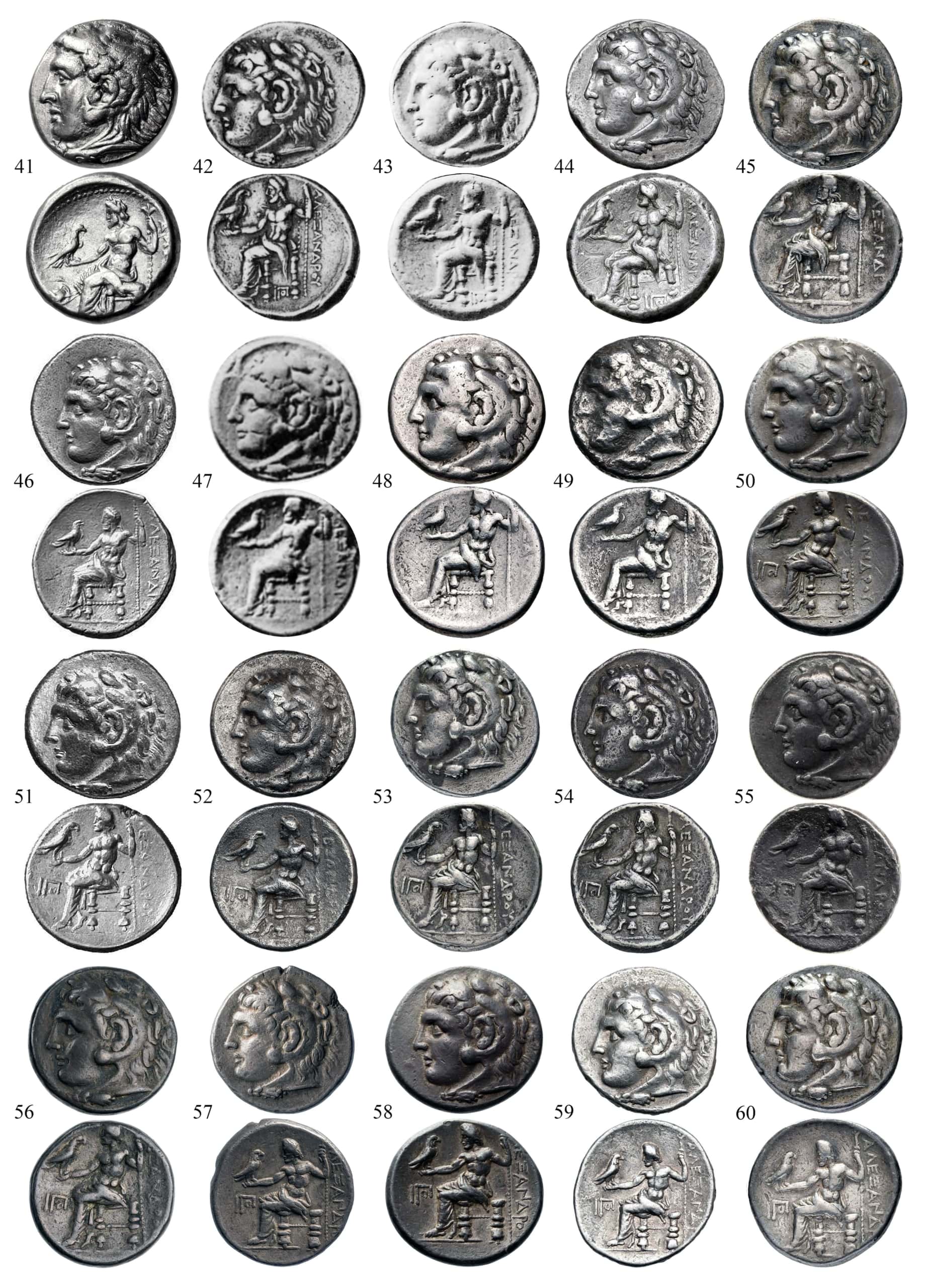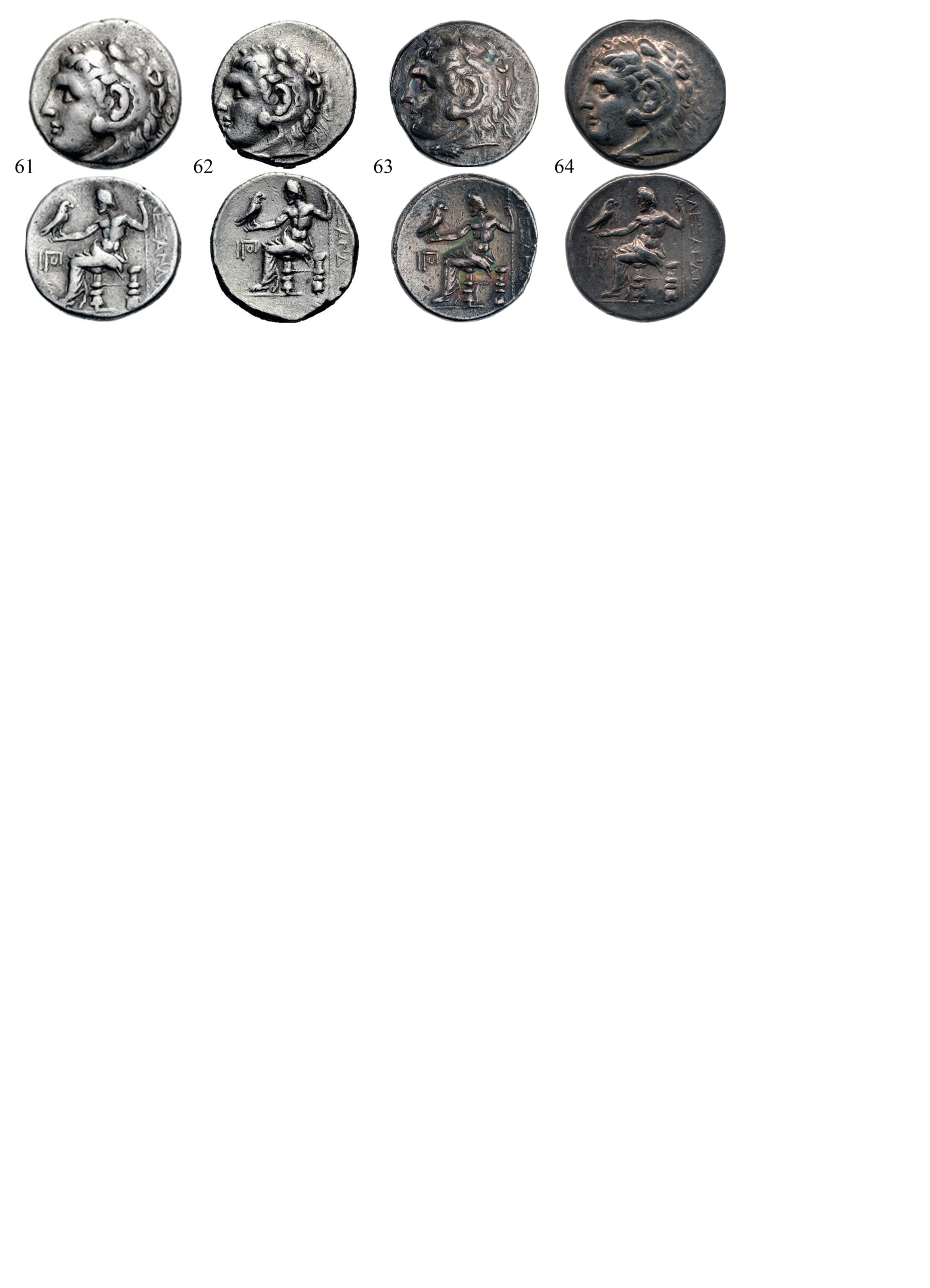Background
The tetradrachms issued under the name of Alexander the Great were among the most wide-spread of all ancient coinage. The obverses of these coins feature a portrait of Herakles facing right and wearing a lion skin headdress, while the reverse depicts Zeus facing left and seated on a throne with staff in one hand and an eagle in the other. Whether the coins were minted in Macedonia, the Black Sea, Egypt, or Media, these features remain largely unchanged. For the more than 2,500 Alexander tetradrachm types catalogued by Martin Price1, the main point of variation among them is only in the control symbols on the reverse or the addition of the Basileus title to the legend. It’s therefore surprising to find that a handful of these tetradrachms were engraved with a left-facing portrait of Herakles. For all the artistic licence that the die engravers had in copying the core motifs of the Alexander tetradrachm, it had never extended so far as to alter the direction in which either Herakles or Zeus faced. It is as if there was an unwritten rule that bound the hundreds, or possibly thousands, of different engravers who were responsible for the millions of Alexander tetradrachms that were minted across several centuries and an area millions of square kilometres in size.
Seven types were identified by Price as having a left-facing portrait of Herakles (LFH), four of which were likely minted in Pella and three ostensibly minted in Cyrene (Table 1). These seven types represent less than half a percent of all known Alexandrine tetradrachms. In terms of known examples, a total of 64 LFH tetradrachms were located online through the ANS PELLA database, acsearch.info, and digitised versions of old auction catalogues and are listed in Table 1. There are approximately 12,000 tetradrachms in the name of Alexander published on the PELLA database and another 12,000 auction listings for such tetradrachms on acsearch.info2, making approximately one in every 375 tetradrachms a LFH example.
| Mint | Region | Price Type | Control | # Examples |
| Pella | Macedon | 204 | Bee | 16 |
| Pella | Macedon | 213A | Θ left | 2 |
| Pella | Macedon | 213 | Θ below | 19 |
| Pella | Macedon | 215 | Attic helmet left | 4 |
| Cyrene | Cyrenaica | 3985 | 5 | |
| Cyrene | Cyrenaica | 3986 | ΙΠΟ left | 15 |
| Cyrene | Cyrenaica | 3987 | ΙΠΟ below | 3 |
Table 1 – Left-facing Herakles tetradrachm types
While no official issues are known to feature a seated Zeus facing right instead of left, it is perhaps more surprising that a variation to the direction of Herakles was introduced at all given the relatively few number of examples that were likely ever minted. The reason for its introduction is still not clear but there are a few clues that can be gleaned from the limited sample available that may make some explanations more likely than others. I will begin with an overview of the LFH coinage at each of the Pella and Cyrene mints before proceeding on to previous explanations given for their production and how those explanations hold up given what we now know about these types and the information that can be discerned from the variation in style across the dies and types.
Discussion
Pella
It is thought that four LFH types were minted at Pella, of which 41 examples have been identified in this study. The four types are differentiated by their control symbol and placement: a bee, theta, or Attic helmet. For three types, the control symbol is found in the left field of the reverse, the exception is Price 213 where the letter Θ is found below Zeus’ throne. Both Nancy Moore and Martin Price placed Price 204, with the bee on the reverse, as the first of the LFH types and the first posthumous Alexander types to be minted at Pella. There are some indications to this ordering, partly in the evolution of the style but also in the wider context of the Pella mint.
The main variable stylistic elements of the LFH types at Pella are found on or near the throne, namely: the cross-struts, footstool, throne stiles, and throne legs. Some dies have no cross struts between the legs while other dies have one or two. The throne stiles, or throne back, can also be either absent, visible only from behind Zeus’ left shoulder, or visible behind both his left and right shoulder. The footstool likewise makes appearances but is far from a consistent attribute. Lastly, the legs of the throne vary between thin stick-like legs with several small mouldings and no sepal leaves adorning the feet, to rounder and more robust-looking legs that are much more decorative, complete with large mouldings, sepal leaves, and tapered upper sections of the legs where they connect to the seat (Fig. 1).
Figure 1 – Reverse styles found across the LFH types attributed to Pella: (a) Price 204, (b) Price 204, (c) Price 213A, (d) Price 213, (e) Price 213, (f) Price 213, (g) Price 213, (h) Price 215.
While some of these changes represent artistic freedom rather than artistic evolution, there does seem to be a general trend in the style of the four LFH types. The earliest examples appear to be those with the less ornamented thrones, two cross-struts, and no throne stiles. These can be found in some dies of Price 204, 213, and 213A. Though in each type the style evolves significantly before the end of the issue. In Price 204 types, the double cross-strut is removed entirely and a thin stile appears behind Zeus, hinting at a throne back. On the other hand, Price 213 sees a development from a more crude rendition of the double cross-strut and stile-less throne to one that is increasingly more ornate and sophisticated, complete with a large backing to the throne visible behind both of Zeus’ shoulders (Fig 1. d-g). Moore believed there were two subgroups of coinage being minted at Pella simultaneously, with the bee type in one subgroup and the theta types in the other subgroup3 (Fig. 2). This is supported by a stylistic analysis.
Figure 3 – Moore’s subgroups of the first posthumous series of Alexandrine tetradrachms issued at Pella. Reproduced from Moore 1984a.
Beginning with Price 213A, with the theta in the left field, we see that the examples with the crudest style closely resemble the style of the examples of Price 204 that have the double cross-strut (Fig. 1c). Both types then iterate on their designs before their issue is complete, although Price 213 undergoes more change than Price 204. As a die analysis will show, Price 213A is linked to Price 213 through obverse die O5 with indications that the die as used on the Price 213A example was in an earlier state at its time of striking. Complicating this is the apparent change in style between Price 213A and the first examples of Price 213 with the double cross-strut and stile-less throne (R7). Given the similarity in these attributes, and lack of deviation in engraving style in other examples, it is surprising to find a certain crudeness in these examples of Price 213 that show a slender Zeus hunched over his throne. The style then returns to normal on subsequent dies of this type. A possible explanation for this is the introduction of a new temporary engraver, which may also explain the change in placement of the control symbol from the left field to below the throne.
As to when these LFH types were struck at Pella, the evidence tends to point towards an early posthumous date. Martin Price suggested 325-315 BC while Moore followed Le Rider’s dating of 323-317 BC, narrowing the terminus of this range to 319 BC for the Group A types that include the left-facing tetradrachms. Perhaps the most important evidence for the dating of types at Pella are the re-emergence of posthumous Philip II tetradrachms.
Le Rider defined two periods that saw posthumous issues of Philip II tetradrachms, the first under Alexander between 336-329 BC (Le Rider Group IIB), and the second under Philip III as regent between 323-315 BC (Le Rider Group III). Both of these groups would feature types that closely paralleled the Alexander types in their use of control symbols. This overlap has been studied by Le Rider, Price, and others and has been instrumental to dating Alexandrine types at Amphipolis and Pella4. In Le Rider’s Group IIB, this overlap occurs only at Amphipolis, where the reverse symbols of fulmen, prow, janiform heads, rudder, and stern are found on the last Philip II tetradrachms of this group and the first Alexander tetradrachms at this mint5. On the other hand, the Philip II types of this group attributed to Pella, circa 336-329 BC, have no such overlap of control symbols with any Alexandrine types that may be attributable to Pella. For this reason, numismatists have been hesitant to attribute any Alexandrine tetradrachms struck during Alexander’s lifetime to Pella6.
Le Rider’s dating of the Philip II types belonging to the period 336-323 BC has gained wide acceptance and it’s generally not disputed that the posthumous types of Philip II ceased production at both Amphipolis and Pella between 329/8 and 323/2 BC. So when Le Rider’s Group III types of Philip II were resumed in 323 BC at both mints, it is argued that this must be when the Pella mint first became operational in terms of Alexandrine coinage. The argument rests on the fact that 11 of the Alexandrine tetradrachms are paralleled in their control symbols by the Philip II tetradrachms (Fig. 4). This is indeed a strong indication that the series were produced concurrently alongside one another but the connection runs even deeper.
Figure 4 -Overlap between control symbol usage in Philip II type tetradrachms and Alexander III type tetradrachms at Pella. Reproduced from Moore 1984a.
Similar to the LFH types of Alexandrine tetradrachms, the first Philip II tetradrachms of Group III were struck with left-facing portraits of Zeus (LFZ) on the obverse (Fig. 5). So not only is there a connection in the control symbols between the Philip and Alexandrine coinage at Pella from 323 BC, both series also have types that feature left-facing obverse portraits for the first time. These LFZ types of Philip II were minted with the same reverse controls as the LFH types, namely a bee and theta – though there is some variation in the legend arrangement7, theta placement8, and one type features controls not found on the LFH types9. There is no LFZ type with the Attic helmet control found on LFH type Price 215, casting doubts on its attribution to this period or the Pella mint entirely.
Nonetheless, the connection between the LFZ and LFH bee and theta controls has led Moore and others to date the LFH types to the beginning of the posthumous period of the mint at Pella alongside the LFZ types. Die-linkage within each of these series has also confirmed that they have the same general sequence in the usage of the control symbols (Fig. 4). Also similar to the LFH types is that each of the LFZ types has a “companion type”, which is where the reverse controls are the same (and sometimes even using the same dies) as the LFH type except that the portrait faces right instead of left.
Figure 5 – Left-facing Zeus tetradrachm in the style of Philip II issued posthumously at Pella under Philip III.
In terms of the ordering within each series, the Philip II types begin with the bee reverse type followed by the theta reverse type, which Price followed for his ordering of the LFH types10. As noted previously, Moore determined that the bee and theta types were likely struck concurrently but it’s possible Price agreed with this as well and his ordering as suggested by the numbered types is just a limitation of that method of cataloguing. In a shorter essay on the Pella mint before the completion of her thesis, Moore even argued that the theta type may precede the bee type due to the stylistic similarities of the right-facing Herakles portraits on the LFH companion type (Price 214) to the portraits of Herakles on tetradrachms attributed to Sicyon by Newell and Noe11.
Moore convincingly argued that some of the tetradrachms that Newell and Noe attributed to Sicyon, and Price attributed to Aegae, are in fact the lifetime coinage of Alexander minted at Pella, namely Price types 187-200. Price himself noted this possibility and admits he attributed them to Aegae hesitantly12. Moore draws particular attention to the double-row of curls in Herakles’ hair that run along the lion’s upper jaw. This feature is particularly rare in Alexandrine coinage outside the issues of Pella and a sole issue at Amphipolis13. The way the lion’s mane curls downward in the first row and then upwards in the back row is also suggestive that these coins may be of the same mint but minted at different times (Fig. 6). While Moore draws stronger comparisons between the theta type and these Sicyon/Aegae tetradrachms, LFH tetradrachms of the bee type also display some similarities, particularly with the later types that Price attributes to Aegea (e.g. Price 200). Nonetheless, it may be the case that the theta type briefly preceded the bee type at Pella or the engravers of that type simply drew more on these earlier types for inspiration.
Figure 6 – Obverse dies of Price 187 and Price 214 showing similarity in the rendition of the lion’s mane and the double-row of locks on Herakles’ forehead.
Price 215
It remains unclear where Price 215 fits into the picture. Nancy Moore does not appear to have mentioned this type in either her thesis or essay, even though examples have long been in the collections of the Berlin Münzkabinett (1875, coin #38), the British Museum (1922, coin #39) and the American Numismatic Society (1944, coin #40). It is possible that she did not consider these types to have likely been minted in Pella and omitted them altogether. Martin Price cites a single example in his work and immediately forgets to include it in his summary of the Pella mint by only counting a total of three varieties minted at Pella with left-facing Herakles portraits (204, 213, and 213A). The one example cited by Price comes from von Prokesch-Osten14 where it was not attributed to a mint. There seems to be little evidence for keeping the attribution to Pella and it may be best to err on the side of caution and consider it as belonging to an unknown mint.
The style of Herakles, Zeus, and Zeus’ throne of the Price 215 examples is quite unlike any other LFH example attributed to Pella, as well as Price 215’s companion type, Price 216. This is unusual when compared to both Price 204 and Price 213, whose companion types (Price 205 and Price 214) are extremely similar in reverse style and have an obverse style consistent with the general portrayal of Herakles at this mint. These companion types also replicate the reverses identically in composition, whereas Price 216 has an additional monogram below the throne. Although the examples of Price 215 have double cross-struts, as known from the other LFH types, they are markedly different to the style of the struts of the early 204, 213, and 213A types (Fig. 1a, c, d, h). This stems from the overall stylistic differences of the throne. The legs have become elongated and slimmer, with the mouldings more closely matching the diameter of the wider cylindrical parts where the legs attach to the apron of the throne. The turned sections of the legs below this are much smaller in diameter and the toroids around their circumference have shrunken to thin rings. The drooping sepal leaves adorning the bottom part of the legs are placed higher up than found on the other types so that there is a clear separation between them and the feet (Fig. 7).
Figure 7 – Comparison of the styles found on the reverses of some examples of Price 213 and Price 215.
Overall, there are few similarities in the thrones of Price 215 with the other LFH types, the style seems on the whole to be distinct rather than an amalgamation of different characteristics. Additionally, all examples of Price 215 depict Zeus with crossed legs, a feature only found on the last examples of Price 213 among the LFH types, so one would expect to see the most similarity between these examples rather than other LFH examples earlier in the series. One possibility is that this type was minted much later in the sequence at Pella, when the general style had evolved significantly further, though this would mean that not only did the left-facing Herakles portrait reappear but that the control symbol reappeared too, for the companion type to Price 215 (Price 216) depicts Zeus with uncrossed legs and of a style much more consistent with Price 213 examples.
An alternative explanation that would see this type retain its sequence as determined by Price would be the introduction of a new engraver. As suggested by Moore, it seems likely that the obverse dies for types Price 204, 213A, and 213 were all cut by the same artist15. The exception would be the obverse dies of Price 215, which clearly indicate the employment of a second engraver. Two features that clearly distinguish the engravers are the treatment of the lion’s mane and the lion’s lips around its jaw. The lion’s mane of the bee and theta types are depicted as neat locks of hair that trend in a similar direction both within the locks and between locks, with most pointing down slightly. This is contrasted by the obverse dies of Price 215 where the locks of hair are wavy, follow different directions, and tend to tick upwards at their ends. The other difference can be found in the line that surrounds Herakles’ ear and represents the lion’s lips. On the bee and theta types, this line is smooth and rounded, unlike the jagged and pointed lion that can be found on the Price 215 examples.
In summary, caution is warranted in attributing Price 215 to Pella, or at least in attributing it to the same period of the mint as the other LFH types. These other types, represented by Price 204, 213A, and 213, surely do belong to Pella and fit neatly into its chronology. Following Moore’s dating, Pella would not mint any Alexandrine tetradrachms between 336 BC and 329/8 BC, only posthumous Philip II types. Perhaps starting as early as 328 BC, Pella would then produce a short series of tetradrachms and other denominations that were previously attributed to Sicyon and Aegae. These issues would have ceased production by 323 BC, if not earlier. Le Rider’s Group III tetradrachms of posthumous Philip II types would be resurrected at Pella under Philip III’s regency following Alexander’s death. These began with left-facing portraits of Zeus on the obverse; perhaps to differentiate them from the earlier posthumous types or simply an oversight given the 5 year gap since the Group IIB types. At the same time, left-facing Herakles tetradrachms would begin production alongside the LFZ types, possibly with the bee and theta types being struck concurrently but without the mixing of obverse dies. The tetradrachms from both series would largely parallel each other in their use of control symbols for the remainder of the period with the last of the LFH types being surely struck by 319 BC.
Cyrene
The issues currently attributed to Cyrene are believed to have been minted circa 305-300 BC but little is known, or has been said, about them otherwise. They are both less studied and less understood compared to the Pella LFH types. Nancy Moore did not include these in her thesis, or reference them, presumably because she believed they had no connection to the mint at Pella besides sharing the left-facing Herakles portrait. Price follows the attribution of Robinson, and later Newell, who believed they belonged to Cyrene based on the monogram in the left field of types Price 3986 and Price 3987. The monogram consists of an Ι, Π, and Ο and can be found on Cyrene didrachms dating to the early 4th century (fig. 8). The Price 3985 tetradrachms with no control symbol were then able to be attributed to the same mint as the other two types based on a shared obverse die.
Figure 8 – ΙΠΟ monogram as it appears on Cyrenean didrachms of the late 4th century versus the LFH types attributed to Cyrene.
These are the only tetradrachm types that Price attributed to the Cyrene mint out of a total of eight types. The others consist of three gold staters, a gold half stater, and one AE unit. Price attributed one of the gold staters and the single half stater to Cyrene based on the prior work of Lucien Naville16, while the AE unit follows Newell’s attribution17, and the remaining two staters feature a silphium plant, a widely recognised symbol of Cyrene and a core design of its later didrachms. The tetradrachms are the only types attributed to this mint with the ΙΠΟ monogram, an unusual finding given the overlap in control marks between the gold and silver coinage of Alexander at other mints18. It is also uncharacteristic for a mint to issue such a short-lived series of Alexander tetradrachms, not to mention from a single obverse die where the portrait of Herakles is facing the wrong direction.
I would argue that there are either tetradrachms from this mint that remain unattributed or misattributed, or these tetradrachms likely belong to another mint. While the connection to the monogram found on the didrachms is useful, it is dangerous to base an attribution solely on a monogram when monograms are frequently used across multiple mints. An example of this can be found in one of the gold staters attributed to Cyrene, Price 3988, where an identical monogram can also be found on the gold staters and tetradrachms of Tarsos as well as a tetradrachm attributed to an unknown Peloponnesian mint19. The attribution of Price 3988 to Cyrene is then primarily dependent on the silphium plant accompanying the monogram on the reverse. Caution is thus advised in attributing Price 3985-87 to Cyrene based on the ΙΠΟ monogram alone.
The lack of other Alexandrine types attributed to Cyrene with either an Herakles obverse or seated Zeus reverse makes assessing the likelihood of its belonging all the more difficult. The only other type with a Herakles portrait is the AE unit, Price 3990. However, it is known from a single example on the ANS PELLA database and none on acsearch.info. The style of this Herakles is nonetheless quite different to that of the tetradrachms but without more examples it is difficult to draw any conclusions from this. An alternative is instead to look for types matching the reverse style. Neither the Alexandrine staters nor AE unit attributed to Cyrene have a seated Zeus, or even seated deity, reverse but Cyrene did issue a rare stater with Zeus seated on a throne that may be useful as a comparison (Fig. 9). Likely issued between 322-314 BC, this stater features a quadriga on the obverse and, on the reverse, Zeus seated on a throne with an eagle resting on an outstretched hand – much like on Alexandrine coinage.
Figure 9 – Gold stater of Cyrene likely issued under Ophellas circa 322-314 BC.
In 322 BC, a former officer of Alexander’s army by the name of Ophellas conquered Cyrenaica on behalf of Ptolemy I. These staters were likely issued during Ophellas’ governorship but before a brief revolt in 313 BC temporarily removed him from power. The timing of this issue puts it squarely in the middle of a period in which Alexander’s coinage had the most influence. Within the next two decades, many of Alexander’s diadochi would have struck coinage in their own name that was directly influenced by the tetradrachms that preceded them. This stater was likely no different and similarly influenced by the seated Zeus reverse featured on the major tetradrachm and drachm coinage of Alexander20. The main difference is the absence of a sceptre in Zeus’ left hand, which instead hangs in the air as the forearm is perched over the throne stile.
This issue of Alexander-influenced staters raises two questions. The first is why did Ptolemy have Ophellas strike an entirely new coinage in Cyrene for a brief period of time and then replace that coinage with a similarly brief issue of Alexandrine tetradrachms a decade later circa 305-300 BC? Between 322 BC and 305 BC, Ptolemy had already begun to issue two tetradrachm series that deviated from the Alexandrine standard. The first kept the seated Zeus reverse but replaced Herakles with a portrait of Alexander the Great himself, wearing an elephant headdress. The second series retained the new portrait of Alexander and replaced the seated Zeus reverse with Athena Promachos. There would appear to be no constraint acting on Ptolemy I that would have required him to mint new Alexander-type tetradrachms as late as 305 BC. The Alexandrine coinage Ptolemy I issued while Satrap of Egypt had all but finished by 305 BC and was merely a continuation of each mint’s existing output at the time of his taking over, such as at Salamis. Upon declaring himself King in 305 BC, he had no reason to initiate a short-lived series of Alexandrine tetradrachms in Cyrene, where they had never been minted previously.
The second question is whether these Cyrenian gold staters of 322-313 BC display any parallels in the reverse with the Price 3985-87 tetradrachms. Immediately, there are obvious differences in the throne of the Ophellas stater compared to the LFH tetradrachms. The throne is intricately detailed with rectangular sections connecting the legs to the apron. Volutes are found both above and below the rectangular sections of the leg in addition to cylindrical scrolls or similar features that occupy a space between the thinned middle section of the leg. These are features of a late Classical to early Hellenistic throne, when the more simplistic and utilitarian thrones of the Archaic and early Classical period are replaced by those with ornate elements and complex designs21. A similar example can be found in Richter’s study of Greek furniture22 (Fig. 10). Thrones of this style are largely of Greek influence and can be found on early posthumous Alexandrine types from mints such as Arados, Pella, and Tarsos. Typically, when this style appeared at a mint it would persist for several types before the throne style is changed yet again to a subsequent design. It may be that this is what occurred at Cyrene, if the tetradrachms were indeed struck there, but it at least seems unlikely that they were produced at the same time as these staters.
Figure 10 – Mid-4th century Greek throne illustrated on a Lekythos showing the rectangular legs and intricate volutes and scrolls. Reproduced from Richter 1966, fig. 111.
Another avenue for determining whether these LFH tetradrachms really belong to Cyrene is the hoard evidence. One would expect more of the tetradrachms to be found in, or close to, Cyrene, rather than further afield. The only LFH tetradrachm of the Cyrene types with hoard provenance in IGCH was found in Corinth23 and I’ve been unable to find other examples with provenances indicating a findspot or similar. The example from this hoard is the LFH type without the reverse monogram, Price 3985 (coin #47). The hoard is thought to have been deposited in 215 BC and contained 385 silver coins, many of which were Alexandrine tetradrachms or drachms. In his study of the hoard, Sydney Noe noted a heavy bias towards coins from mints of Asia Minor: 88 out of 96 drachms and 7 out of 20 tetradrachms24. Of the remaining Alexandrine tetradrachms, six were from the Peloponnese and five from other Greek cities. It’s worth considering further whether the presence of a Cyrenaican coin is unexpected given its other contents.
In addition to the coins of Asia Minor, a further 90 tetradrachms minted by Ptolemaic rulers were found in the hoard, though not all were from Egypt and many were instead minted in Phoenician cities. The proximity of Egypt to Cyrenaica both geographically and politically might suggest that this is the likely explanation of how the Cyrene tetradrachm ended up in the hoard. However, the city of Cyrene is about 200 km closer to Corinth as the crow flies than it is to Alexandria, and Cyrene was known to have active trade routes with many Greek cities. Noe speculates that the Ptolemaic coins in the hoard may have found their way to Corinth through trade and offers the high frequency of graffiti on these tetradrachms as evidence they were perhaps marked on import into the Peloponnesian city. The Cyrenian tetradrachm appears to have no such graffiti, further indicating it did not first travel to Alexandria and then onto Corinth, which would have otherwise explained the paucity of other Cyrenian coinage in the hoard. The simplest explanation is that the coin found its way to Corinth directly via one of these trade routes. Given that scenario, one might expect more coins of Cyrene, such as their Silphium didrachms, to have also found their way into the hoard given that at least one made it.
Regrettably, this hoard is unable to offer much evidence one way or the other as to whether types Price 3985-87 belong to Cyrene or should be attributed elsewhere. We are left with little conclusive evidence one way or the other as to the mint of these LFH tetradrachms attributed to Cyrene. The absence of Alexander-style tetradrachms minted by cities under Ptolemaic rule after 305 BC would strongly argue for a minting date between 322 BC and 305 BC, if they were to be minted in Cyrene. However, the style of the earlier gold staters minted under Ophellas would suggest these coins were not contemporary with the LFH types. That leaves a small date range of between 313 BC to 305 BC, which is further narrowed when considering the coinage of Ophellas’ short second reign. Returning to power in 312 BC, he briefly struck additional gold staters with a quadriga obverse, but this time featuring a standing Zeus Ammon on the reverse. These staters were last struck in 309 BC. It would seem unlikely for the LFH tetradrachms of Price 3985-87 to have then been struck in the brief gap between 309 BC and 305 BC considering they would’ve been a new denomination and type for Cyrene under Hellenistic rule, of extremely limited production using a single obverse die, with a portrait of Herakles facing the wrong direction, and only a few years before all of Ptolemy’s mints had ceased production of Alexandrine tetradrachms. On the balance of the evidence, the LFH types attributed to Cyrene should be considered to belong to an unknown mint.
Dies
Pella
The left-facing Herakles (LFH) types attributed to Pella consist of 9 obverse dies and 15 reverse dies with no die-links between types except for obverse die O5 linking Price 213A to Price 213. This lack of die-linkage is consistent with the parallel series of posthumous Philip II tetradrachms with left-facing Zeus (LZH) portraits25. Some die-linkage exists between the reverses of the LFH types and their companion right-facing Herakles types, which is also found among the LZH types. Overall, the production of LFH types at Pella appears to be relatively small, with no more than 3 obverse dies identified for each type and an average reverse-to-obverse die ratio of less than two (Table 2).
| Price Type | Control | # Examples | Avg Weight | Obv Dies | Rev Dies | Die Links |
| 204 | Bee | 16 | 17.13 | 3 | 5 | Rev link to 205 |
| 213A | Θ left | 2 | 17.22 | 2 | 1 | Obv link to 213 |
| 213 | Θ below | 18 | 17.10 | 2 | 7 | Rev link to 214 |
| 215 | Attic helmet left | 4 | 16.88 | 3 | 2 |
Table 2 – LFH types attributed to Pella
Using Esty’s formula for estimating the original number of dies26, we arrive at 11.5 obverse dies and 26.2 reverse dies for the LFH types at Pella for a ratio of 2.27 reverse dies per obverse die27. According to de Callataÿ’s estimate of 20,000 tetradrachms per obverse die, this would put the total output at 230,000 tetradrachms – a relatively small number in the context of the mint as a whole. As mentioned earlier, there were likely two subgroups of LFH types being minted at approximately the same time. The lack of obverse die linkage between these groups, as well as a look at the evolution of the styles within each group, reinforces this theory.
The bee type, or Price 204, is often listed as the first type out of the left-facing types at Pella so beginning with these dies we can track the development of characteristics apparent on the reverses to determine the order in which they may have been engraved. The main features that vary across these particular dies are the number of cross-struts, the stile of the back of the throne, the footstool, and Zeus’ himation. Three reverse dies depict two cross-struts and two reverse dies depict no cross-struts. The other difference between these dies is the drapery of Zeus’ himation. The dies with no cross-struts do not show the himation drooping below the throne, but this is found in two of the reverse dies with cross-struts. It may be that the one die with cross-struts but no drapery below the throne is of intermediary style. Similarly, the appearance of the footstool perfectly coincides with the appearance of the drapery below the throne. Lastly, a single reverse die, lacking cross struts, footstool, and drapery, has a faint stile behind Zeus’ left shoulder, indicating a backing to the throne. One could assume that there is either a progress from cross-struts, drapery, and footstool to a style lacking all of these but with the addition of a throne stile, or vice versa. After considering the other types, the former option seems most likely.
The types Price 213 and 213A with the theta control symbol mirror many of the characteristics found in the bee type. However, there is more variation, or development, within these theta types. Reverse dies can be found with two cross-struts below the throne but these lack the footstool and drapery, though they also do not have a stile behind Zeus. At this point, the three types discussed so far depict Zeus with uncrossed legs and sitting on a throne with relatively simple leg design. However, we can find reverse dies of Price 213 that begin to change both the leg position and style of the throne legs. These dies have a single cross-strut, drapery below the throne, and stiles behind both of Zeus’ shoulders with vertical and horizontal “ears” jutting out. The footstool is not a fixed element of these dies and the ornamented legs of the throne appear before Zeus’ legs are depicted as crossed.
A pattern can begin to be discerned with the help of Table 3. Undoubtedly, we know the sequence of dies should begin with those that depict Zeus with uncrossed legs. It also seems likely that the more simplistic throne style would be found first, as this is most similar to the earliest examples from Amphipolis and the ornamented throne style is typical of the evolving Hellenistic style. Lastly, the throne stiles, or backing to the throne, also appear to be a later addition as they also tend to make a late appearance at mints producing Alexandrine coinage. However, it’s only when we split type Price 204 into one subgroup and Price 213 and 213A into a second subgroup that the sequence makes sense. Without this, the elements of the reverse so far discussed would seemingly alternate between dies randomly. The subgroups instead show parallel development of style. Price 204 begins with two cross struts and no throne stiles, and ends with no cross struts and a slight stile behind one shoulder. Price 213A matches the earliest style of Price 204 in these regards. Lastly, Price 213 also begins with these same elements before reducing the cross-struts to one and adding two large stiles behind Zeus, complete with vertical and horizontal pointed “ears”.
| Price Type | Subgroup | Cross-struts | Throne Legs | Throne Stiles | Footstool | Drapery below Apron | Zeus’ Legs |
| 204 (early) | 1 | 2 | Simple | No | Yes | Both | Uncrossed |
| 204 (late) | 1 | 0 | Simple | Left | No | No | Uncrossed |
| 213A | 2 | 2 | Simple | No | No | No | Uncrossed |
| 213 (early) | 2 | 2 | Simple | No | No | No | Uncrossed |
| 213 (late) | 2 | 1 | Ornamented | Left & Right | Both | Yes | Both |
| 215 | – | 2 | Ornamented | No | Yes | No | Crossed |
Table 3 – Comparison of certain attributes that appear on the reverses of LFH types attributed to Pella.
Nancy Moore likewise noted this parallel evolution of style between the subgroups28 where both subgroups had LFH or RFH examples demonstrating the three types of reverse styles she had defined. According to this categorisation, Price 204 only exhibits reverses of Type 1 style, while the theta LFH types (Price 213-213A) have examples that cover all three styles. There is even a single obverse die, O5, that is paired with all three reverse style types within the second subgroup.
The only die link between these four LFH types attributed to Pella is O5, linking Price 213A and 213. While Price29 has type 213 preceding 213A, there are a few clues that suggest the reverse ordering. The obverse die O5 appears to have been recut after being used with the 213A reverse, most notably in the second row of the lion’s mane at the back of the headdress (Fig. 11). The two known reverse dies of 213A also lack throne stiles and have two cross-struts between the throne legs, following the stylistic evolution described earlier. Stylistically, they are extremely close to the “early” examples from Price 204. There is also no direct companion type to 213A, i.e. a right-facing Herakles paired with a theta below the throne on the reverse. This might suggest that this placement was temporary or inadvertent and when the theta was moved to the left field, the companion type Price 214 followed suit.
Figure 11 – Obverse die O5 shows signs of having been recut in the back row of the lion’s mane, suggesting Price 213A precedes Price 213.
No other die-linkages across LFH types have been documented previously or were uncovered by this study. This would further support Moore’s theory that type Price 204 and types Price 213A and 213 were struck concurrently as two separate issues rather than sequentially. However, there are reverse die-linkages between LFH types and RFH companion types. Moore reported two die matches between Price 204 and Price 205, specifically her reverse dies labelled “B” and “D” from the bee reverse type30. While I was unable to find an RFH specimen matching Moore’s “B” die, I was able to locate one reverse die match of an example of Price 205 that matches R5 / Moore’s D reverse die31a. Additionally, there are at least two examples of die-linkage between Price 213 and its companion type Price 21431b. Reverse dies R10 and R12 as identified in this study are matches to reverse dies of Price 214. The combination of parallel stylistic evolution, lack of die matches between bee and theta types, and die matches to their respective companion types strongly suggests these types were contemporaneous but separate and the lack of obverse die sharing may be indicative of how the mint at Pella was structured.
Cyrene
The LFH types attributed to Cyrene consist of a single obverse die and 6 reverse dies, meaning all three types share the same obverse die (Table 4). This is quite unusual for a mint that apparently struck no other Alexandrine tetradrachms as it would suggest the total production of the mint for these types was approximately 20,000 tetradrachms. It would hardly seem worth the trouble. Applying Esty’s formula for estimating the original number of dies, we arrive at 1 obverse die and 8 reverse dies. This would appear to be about right given two of the reverse dies in this sample are singletons (R17 and R18).
| Price Type | Control | # Examples | Avg Weight | Obv Dies | Rev Dies | Die Links |
| 3985 | 5 | 16.71 | 1 | 2 | Obv link to 3986/7 | |
| 3986 | ΙΠΟ left | 15 | 16.94 | 1 | 2 | Obv link to 3985/7 |
| 3987 | ΙΠΟ below | 3 | 17.06 | 1 | 2 | Obv link to 3985/6 |
Table 4 – LFH types attributed to Cyrene.
In addition to the troubled attribution of these types to Cyrene as previously discussed, the proposed order of the types as per Price may require some revision. Similar to the analysis undertaken for the Pella types, we will attempt to demonstrate a stylistic development across the types that could shed some light on which are the earliest dies and types. Although Price rarely devoted more than a sentence or two to specific types at each mint, which is understandable given the scope of his work, we can theorise the likely reasons for how he ordered these types.
The main argument would likely relate to the variation in monogram on the reverse, namely: no monogram, monogram in the left field, and monogram below the throne. Perhaps the logical assumption is that the monogram-less type would come first. As for deciding the order of the monogrammed types, it may have simply been guesswork given Price may have only been able to examine a single specimen of type 3987. Applying a stylistic analysis, as well as a close inspection of the die states, may lead us to a different conclusion.
To begin with the stylistic approach, we see that across the three LFH types attributed to Cyrene, there are some elements of the reverse which remain consistent and other elements which appear to deviate significantly (Fig. 12). The throne found on Price 3985 and Price 3986 examples is stout with a wide base and thick legs. The mouldings of the legs are similarly broad and lacking in finesse. The detailed sepal leaves and mouldings found on other Alexandrine tetradrachms are nowhere to be found in these examples. Zeus sits forward on the throne leaving space behind him above the back leg where there is an absence of throne stiles. A single cross-strut joins the legs from about halfway up and hanging slightly above is Zeus’ himation drooped over the side of the throne.
The single cross-strut and loose himation fold are also found on reverses of Price 3987 but the cross strut is placed much higher up the throne legs and the himation is rendered with more skill. Moreover, the shape of the mouldings of the leg are more faithful to an actual throne with the upper tapered sections capped by bosses at either end. Greater space can be found between the individual mouldings and the proportions of the throne are more slender. Zeus’ posture is also noticeably more upright among the Price 3987 examples, with a proportionally larger eagle sitting on his hand. Lastly, Zeus is seated further back and behind each shoulder stiles can be found, providing a back to the throne. These attributes point towards an engraver of a different style, or perhaps one that is replicating the style of another engraver, compared to the examples of Price 3985-6.
Figure 12 – Variations in the throne across types Price 3985 (left), 3986 (middle), and 3987 (right).
There are few discrete elements of the thrones from across these three types that can be found on two types but not the other, which would be immensely useful in determining the sequence of striking. The himation below the throne is found on all three types and the throne stiles are found only on one type. The other characteristics mentioned have more of a continuous development than a discrete one, introducing subjectivity to the analysis. There are, however, two more characteristics that suggest the direction of this development. Reverse dies R16 and R17, of Price 3987, have a faint row of dots just below the apron of the throne, representing a decorative element of the throne rather than a cross-strut32. This is not found on the reverse dies of Price 3986. It is, however, found on reverse die R19 of Price 3985 but not on reverse die R18 of the same type, suggesting R19 should precede R1833 and Price 3985 is an intermediary type in the stylistic development of these LFH three types.
The second element is the aforementioned position of Zeus on the throne. On Price 3987 dies, he is placed further back, though in reverse die R17 we can see he has begun to shift forward with a fold of his himation covering the space behind him. This is also seen on reverse die R19 of Price 3985, while R18 of the same type has no loose himation behind Zeus and the gap at the back of the throne is now exposed. The gap is then present on both dies of Price 3986. This suggests the same sequence as the dotted frame of the throne, with Price 3985 placed in the middle of the sequence.
A comparison of Zeus’ posture across these types may help us determine whether the sequence begins with Price 3987 or Price 3986. Both reverse dies of Price 3985 published here show Zeus leaning back slightly, while the two reverse dies of Price 3987 have Zeus seated upright, and the two reverse dies of Price 3986 have Zeus shift from an upright position to hunched-over position. This might suggest the sequence to the striking of the reverse dies from leaning-back, to upright, and finally to hunched over. However, the previous analysis of the throne suggests Price 3985, with Zeus leaning back, is likely in the middle of the sequence. In other cases it may be indicative of multiple reverse dies being used simultaneously but given that all examples of these Cyrenean LFH types share the same obverse die, it seems likely the reverses were struck sequentially rather than randomly paired with the same obverse die on different occasions.
The differences in throne style across the types do, in my opinion, suggest a particular order. The sequence of Price 3987-3985-3986 represents a progression from a slender and more ornate throne of Price 3987 to a slightly broader and cruder throne of Price 3985, before reaching its form as found in some Price 3986 examples. One problem with this sequence, aside from the inconsistent changes in posture of Zeus, is that it would mean the ΙΠΟ monogram would appear below the throne, then disappear, and then reappear in the left field. A small die break on Herakles’ neck may help us untangle these inconsistencies between posture, throne style, and monogram placement.
Just below the jaw of the lion’s headdress, a small die break can be seen progressing upwards from the neck. The die break appears to be in its smallest form in an example of Price 3987 but it is not much larger as found in Price 3985 examples (Fig. 13). The lack of high quality photos, or more specimens, reduces the certainty in which we can say the die break is progressing. However, it is clear that the die break is largest among examples of Price 3986. Given the tentative direction suggested by the die break, as well as the throne style and artistry in which Zeus is portrayed, it seems likely that Price 3987 was in fact the first reverse type, followed by Price 3985, and then Price 3986. This would mean the monogram first appeared below the throne, before disappearing altogether, and later reappearing in the left field – all within the relatively short timespan in which these coins must have been struck.
Figure 13 – Progression of a die break in obverse die O10 across Price 3987 (left), Price 3985 (middle), and Price 3986 (right).
The disappearance of the monogram is not completely unparalleled in Alexandrine coinage. The issues from Damaskos, Pella, and Tyre all include types with no control symbols that interrupt the sequence of minting. Price 217 from Pella has no control symbols and succeeds Price 216, the companion type to LFH type Price 215, which features an Attic helmet in the left field. At Damaskos, Price 3201 without control symbols or monogram interrupts the minting of a reverse type with the eponymous ΔΑ monogram and a globule above the cross-strut34. Similarly, at Tarsos, Price 2999 with no control symbols inserts itself between types with a well-sequenced control symbol system35.
This sequence would happen to mirror that which we established for the Pella mint. Instead of moving from a more simplistic throne with no backing to an ornamented throne with large stiles and ears behind Zeus, we start with a slightly more realistic throne portrayal with a delicate stile behind Zeus and move to a robust but rudimentary throne that lacks stylistic characteristics such as throne stiles and ears. This may seem contradictory to the arguments presented for the Pella types but is not an unusual finding given these types are likely of different mints or different periods. Alexandrine coinage rarely established a stylistic system that was paralleled across mints, the few exceptions relate to the position of Zeus’ legs, the orientation of his hand, and the addition of the royal title36. Even then, there are exceptions to these exceptions, such as at Susa where Zeus was still portrayed with uncrossed legs nearly 100 years after the first Alexandrine mint had changed to crossed legs. Apart from those examples, patterns discernible at some mints did not exist at others, or trended in different directions.
Conclusion
The left-facing Herakles tetradrachms of Alexander have received surprisingly little attention in the literature given their uniqueness across such an important and vast coinage. Perhaps the reason is due to the belief that we should attach no import to their existence, that they likely represent an engraver’s mistake or a brief and unsuccessful attempt at adding some variety to a largely homogenous group of coins. The types from Cyrene in particular have eluded a serious analysis of their attribution and features, and this particular study is not intended to fill that gap. However, from a brief analysis of some stylistic traits, as well as die states, it seems likely that the sequence of these Cyrenian types should likely be changed by placing Price 3987 at the beginning and Price 3986 at the end. Additionally, there are some significant doubts as to their belonging at Cyrene, and henceforth the most cautious approach would be to consider them of unknown origin.
Similarly, there are some changes to the sequence of the LFH types at Pella that are suggested by the previous analysis. Nancy Moore may be correct in that there were two subgroups that minted the types in parallel but it would seem that Price 213A, with the theta in the left field, should belong to the beginning of the second subgroup, preceding Price 213. Additionally, there are concerns in the attribution of Price 215 to this same period of the mint’s operation, or even to Pella entirely. An alternative suggestion for where or when this type was minted is not presented here but enough doubt exists that it should only be attributed to Pella tentatively.
Catalogue
| # | Dies | Moore | Weight | Diameter | Axis | Source | Earliest Provenance |
|---|---|---|---|---|---|---|---|
| PELLA | |||||||
| Bee in left field (Price 204) | |||||||
| 1 | O1/R1 | 2-C | 17.17 | CNG Mail Bid Sale 66, 193 (19/05/2004) | 2004 | ||
| 2 | O1/R1 | 2-C | 17.04 | 5 | Roma E-Sale 107, 248 (16/03/2023) | 2023 | |
| 3 | O1/R2 | 2-A | 17.26 | Gorny & Mosch Auction 118, 1253 (15/10/2002) | 2002 | ||
| 4 | O1/R2 | 2-A (3) | 17.16 | Naville The Pozzi Collection, 910 (04/04/1921) | 1921 | ||
| 5 | O1/R3 | 2-B | 17.22 | Stack's Bowers The Vermeule, Ward, and Mexico Maxico Collections, 230 (11/01/2010) | 2010 | ||
| 6 | O1/R3 | 2-B (2) | 17.22 | 25.00 | Jacob Hirsch Sammlung Gustav Philipsen, 520 (29/11/1909) | 1909 | |
| 7 | O2/R1 | 3-C (5) | 17.20 | Hess AG Aktiengesellschaft, 572 (28/04/1936) | 1936 | ||
| 8 | O2/R2 | 3-A | 17.19 | 1 | CNG Triton IX, 757 (10/01/2006) | 2006 | |
| 9 | O2/R4 | 3- | 17.14 | 11 | British Museum, 2002,0101.112 | 2002 | |
| 10 | O2/R5 | 3-D | 16.66 | 25.00 | 7 | CNG Triton XVII, 152 (07/01/2014); Naville IV, 466 (17/06/1922); Sotheby, Wilkinson & Hodge, 253 (28/06/1887) | 1887 |
| 11 | O2/R5 | 3-D (6) | 17.12 | Naville The Clarence S. Bement Collection, 748 (28/01/1924) | 1924 | ||
| 12 | O2/R5 | 3-D | 17.24 | 9 | British Museum, 1893,0604.10 | 1893 | |
| 13 | O2/R5 | 3-D | 17.24 | 6 | iBelgica March 2019 Auction, 105 (19/03/2019) | 2019 | |
| 14 | O2/R5 | 3-D (8) | 17.13 | 9 | ANS, 1944.100.29333; Newell 'Demanhur', 1599-00 (1923) | 1905 | |
| 15 | O2/R5 | 3-D (7) | 17.13 | 2 | ANS, 1944.100.29334; Newell 'Demanhur', 1599-00 (1923) | 1905 | |
| 16 | O3/R5 | -D | 17.13 | Jean Vinchon Numismatique, 58 (07/11/1977) | 1977 | ||
| Θ in left field (Price 213A) | |||||||
| 17 | O4/R6 | 17.21 | Gemini Auction IX, 63 (08/01/2012) | 2012 | |||
| 18 | O5/R6 | 4- | 17.23 | 25.00 | 5 | Roma E-Live Auction 5, 300 (27/09/2022); HD Rauch Auction 90, 90 (04/06/2012) | 2012 |
| Θ below throne (Price 213) | |||||||
| 19 | O5/R7 | 4- | 17.08 | Gorny & Mosch Auction 216, 2305 (15/10/2013) | 2013 | ||
| 20 | O5/R7 | 4- | 17.26 | 24.00 | 7 | Nomos Auction 23, 76 (30/11/2021); Nomos Auction 15, 71 (22/10/2017) | 2017 |
| 21 | O5/R8 | 4- | 17.21 | 25.00 | 12 | Heritage Auctions Auction #3107 , 30017 (03/05/2023) | 2023 |
| 22 | O5/R8 | 4- | 16.90 | 24.00 | 3 | CNG Auction 93, 156 (22/05/2013) | 2013 |
| 23 | O5/R9 | 4- | 17.26 | 27.00 | 7 | Nomos Auction 19, 83 (17/11/2019) | 2019 |
| 24 | O6/R10 | 5-C (14) | 17.21 | 12 | ANS, 1944.100.29335; Newell 'Demanhur', 1601-03 (1923) | 1905 | |
| 25 | O6/R10 | 5-C (12) | 17.20 | 2 | ANS, 1944.100.29337; Newell 'Demanhur', 1601-03 (1923) | 1905 | |
| 26 | O6/R10 | 5-C (13) | 17.21 | 3 | ANS, 1944.100.29336; Newell 'Demanhur', 1601-03 (1923) | 1905 | |
| 27 | O6/R10 | 5-C | 17.12 | 25.00 | 2 | Münzkabinett (Berlin), 18251081 | 1875 |
| 28 | O6/R10 | 5-C | 17.30 | Cahn Auction 65, 125 (15/10/1929) | 1929 | ||
| 29 | O6/R10 | 5-C | 17.09 | Stack's Bowers, 177 (10/06/1970) | 1970 | ||
| 30 | O6/R11 | 5- | 17.00 | 25.00 | 3 | Heritage Auctions Auction 3056, 30055 (03/08/2017) | 2017 |
| 31 | O6/R12 | 5-E | 17.24 | 26.00 | 9 | Roma Auction 15, 114 (05/04/2018); Roma Auction 8, 412 (28/09/2014) | 2014 |
| 32 | O6/R12 | 5-E (16) | 17.22 | Bank Leu 45, 129 (26/05/1988); Hess Leu Auction 19, 182 (12/04/1962) | 1962 | ||
| 33 | O6/R12 | 5-F (17) | 17.25 | R. Jameson Collection Vol. III, 1987 (1924); Bank Leu Sammlung Walter Niggler, 237 (3/12/1965) | 1924 | ||
| 34 | O5/R13 | 4-A | 17.22 | 26.00 | 10 | Münzkabinett (Wien), ID97796 | |
| 35 | O5/R13 | 4-A (10) | 17.21 | 11 | British Museum, 1866,1201.1060 | 1866 | |
| 36 | O5/R13 | 4-A | 16.38 | Stack's Bowers The Vermeule, Ward, and Mexico Maxico Collections, 231 (11/01/2010) | 2010 | ||
| 37 | O5/R13 | 4-A | Heritage Auctions Auction 311, 14094 (10/01/2003) | 2003 | |||
| Attic helmet in left field (Price 215) | |||||||
| 38 | O7/R14 | 17.02 | 27.00 | Münzkabinett (Berlin), 18254204 | 1875 | ||
| 39 | O7/R14 | 16.94 | British Museum, 1922,1020.54 | 1922 | |||
| 40 | O8/R15 | 16.52 | 9 | ANS, 1944.100.29711 | 1944 | ||
| 41 | O9/R15 | 17.05 | 22.00 | 9 | Maison Palombo Auction 19, 31 (12/12/2020); CNG Auction 96, 51 (14/05/2014) | 2014 | |
| CYRENE | |||||||
| Monogram consisting of Ι, Π, and Ο below throne (Price 3987) | |||||||
| 42 | O10/R16 | 17.00 | Jean Vinchon Numismatique, 24 (30/03/1980) | 1980 | |||
| 43 | O10/R16 | 17.05 | 26.00 | Egger Sammlung Theodor Prowe, 582 (02/05/1912) | 1912 | ||
| 44 | O10/R17 | 17.14 | 27.00 | 12 | Roma E-Sale 76, 162 (05/11/2020) | 2020 | |
| No control symbol (Price 3985) | |||||||
| 45 | O10/R18 | 16.69 | 26.00 | Münzkabinett (Berlin), 18253685 | 1853 | ||
| 46 | O10/R19 | 16.99 | Gorny & Mosch Auction 121, 89 (10/03/2003) | 2003 | |||
| 47 | O10/R19 | 16.92 | Noe, Sydney P. The Corinth Hoard of 1938, 161 | 1938 | |||
| 48 | O10/R19 | 16.56 | 26.00 | 12 | CNG Electronic Auction 417, 301 (28/03/2018) | 2018 | |
| 49 | O10/R19 | 16.40 | 26.00 | 12 | CNG Electronic Auction 363, 204 (11/11/2015) | 2015 | |
| Monogram consisting of Ι, Π, and Ο in left field (Price 3986) | |||||||
| 50 | O10/R20 | 16.98 | 27.00 | 12 | Ashmolean Museum, HCR23804 | 1947 | |
| 51 | O10/R20 | 17.07 | 27.00 | 12 | Numismatik Lanz Auction 117, 229 (24/11/2003) | 2003 | |
| 52 | O10/R20 | 16.82 | 27.00 | 12 | Heritage Auctions Auction 3102, 32036 (02/11/2022) | 2022 | |
| 53 | O10/R20 | 17.11 | 27.00 | 12 | Münzkabinett (Berlin), 18253684 | 1906 | |
| 54 | O10/R20 | 17.03 | Künker eLive Auction 71, 109 (09/05/2022) | 2022 | |||
| 55 | O10/R20 | 16.77 | 12 | British Museum, 2002,0101.984 | 2002 | ||
| 56 | O10/R20 | 16.98 | 25.00 | 12 | ANS, 1944.100.35723 | 1944 | |
| 57 | O10/R21 | 17.08 | 27.00 | 1 | Münzkabinett (Wien), ID97747 | ||
| 58 | O10/R21 | 17.08 | 26.70 | 12 | Ashmolean Museum, HCR23805 | 1987 | |
| 59 | O10/R21 | 17.02 | 28.00 | 12 | Nomos Obolos Web Auction 19, 184 (08/05/2021) | 2021 | |
| 60 | O10/R21 | 16.98 | 28.00 | 12 | Münzkabinett (Berlin), 18253683 | 1875 | |
| 61 | O10/R21 | 16.75 | 28.00 | CNG Electronic Auction 101, 21 (10/11/2004) | 2004 | ||
| 62 | O10/R21 | 16.96 | HD Rauch Summer Auction 2010, 149 (13/09/2010) | 2010 | |||
| 63 | O10/R21 | 16.72 | 25.50 | 1 | ANS, 1944.100.35722 | 1944 | |
| 64 | O10/R21 | 17.08 | 12 | British Museum, 1871,1202.1 | 1871 | ||
Footnotes
-
- Price 1991.
- While these auction listings undoubtedly include duplicates of the same coin being sold more than once, at the very least a similar number of coins likely exist in other collections that are not included in acsearch. Therefore an estimate of 24,000 surviving Alexandrine tetradrachms strikes me as a conservative estimate rather than optimistic.
- Moore 1984a.
- see: Le Rider 1977, Price 1982, Moore 1984a, Troxell 1997.
- Troxell 1997.
- Le Rider 1977, see: Price 1991, Moore 1984b for discussion.
- Numismatik Naumann Auction 125, 87 (5 February 2023).
- CNG Electronic Auction 421, 68 (30 May 2018).
- CNG Auction 93, 155 (22 May 2013).
- Le Rider 1977, Price 1991, Moore 1984a.
- Moore 1984, Newell & Noe 1950.
- Price 1991.
- See: Troxell 1997.
- von Prokesch-Osten 1873.
- Moore 1984b, p. 15.
- Naville 1951.
- Newell 1938.
- See: Arados, Babylon, Citium, Salamis, Susa
- See: http://numismatics.org/pella/id/price.3045, https://numismatics.org/pella/id/price.763
- Numismatica Ars Classica, https://www.acsearch.info/search.html?id=9543402
- Richter 1966.
- Ibid. fig. 111
- http://coinhoards.org/id/igch0187
- Noe 1962.
- Moore 1984a.
- Esty 2011.
- de Callataÿ 2011.
- Moore 1984a, p. 18-19.
- Price 1991.
- Moore 1984a, p. 102-103.
- (a) CNG Electronic Auction 262, lot 53 (17/08/2011); (b) ANS 1965.77.24, ANS 1944.100.29341
- Taylor 2018a p. 19 footnote 16.
- R19 should be placed before R18 in my die sequence, i.e. they should switch die numbers, but alas the mistake was noted too late.
- Taylor 2017 p. 56.
- Newell 1919.
- Taylor 2018b.
Bibliography
de Callataÿ, F. (2011). Quantifying Monetary Production in Greco-Roman Times: a General Frame. In F. de Callataÿ (Ed.), Quantifying Monetary Supplies in Greco-Roman Times (pp. 7–29).
Esty, W. W. (2011). The Geometric Model for Estimating the Number of Dies. In F. de Callataÿ (Ed.), Quantifying Monetary Supplies in Greco-Roman Times.
Le Rider, G. (1977). Le monnayage d’argent et d’or de Philippe II frappé en Macédoine de 359 à 294. É. Bourgey.
Moore, N. (1984a). The Lifetime and Early Posthumous Coinage of Alexander the Great from Pella.
Moore, N. (1984b). The Silver Coinage of Alexander from Pella. In Ancient Coins of the Graeco-Roman World: The Nickle Numismatic Papers.
Naville, L. (1951). Les monnaies d’or de la Cyrénaïque de 450 à 250 avant J.-C.: contribution à l’étude des monnaies grecques antiques. Atar.
Newell, E. T. (1919). Tarsos Under Alexander. The American Numismatic Society.
Newell, E. T. (1938). Miscellanea numismatica. American Numismatic Society.
Noe, S. P. (1962). The Corinth Hoard of 1938. Museum Notes (American Numismatic Society), 10, 9–41.
Noe, S. P., & Newell, E. T. (1950). The Alexander Coinage of Sicyon / Arr. From Notes of Edward T. Newell With Comments and Additions by Sydney P. Noe. In Numismatic Studies (Issue 6).
Price, M. J. (1991). The Coinage in the Name of Alexander the Great and Philip Arrhidaeus. In British Museum Catalogue.
Richter, G. M. A. (1966). The Furniture of the Greeks, Etruscans and Romans.
Robinson, E. S. G. (1927). A Catalog of the Greek Coins in the British Museum: The Greek Coins of Cyrenaica.
Taylor, L. W. H. (2017). The Damaskos Mint of Alexander the Great. In American Journal of Numismatics (Vol. 15).
Taylor, L. W. H. (2018a). The Earliest Alexander III Tetradrachm Coinage of Babylon: Iconographic Development and Chronology. American Journal of Numismatics, 30, 1–44.
Taylor, L. W. H. (2018b). The Karne Alexanders. Journal of the Numismatic Association of Australia, 29.
Troxell, H. A. (1997). Studies in the Macedonian Coinage of Alexander the Great. In The American Numismatic Society (Vol. 48, Issue 2). https://doi.org/10.1093/cr/48.2.452
von Prokesch-Osten, A. (1873). Suite des monnaies inédites d’or et d’argent d’Alexandre le Grand. Numismatische Zeitschrift, 3, 51–72.
Stay up to date with the latest news from Artemis Collection by subscribing to the newsletter.

